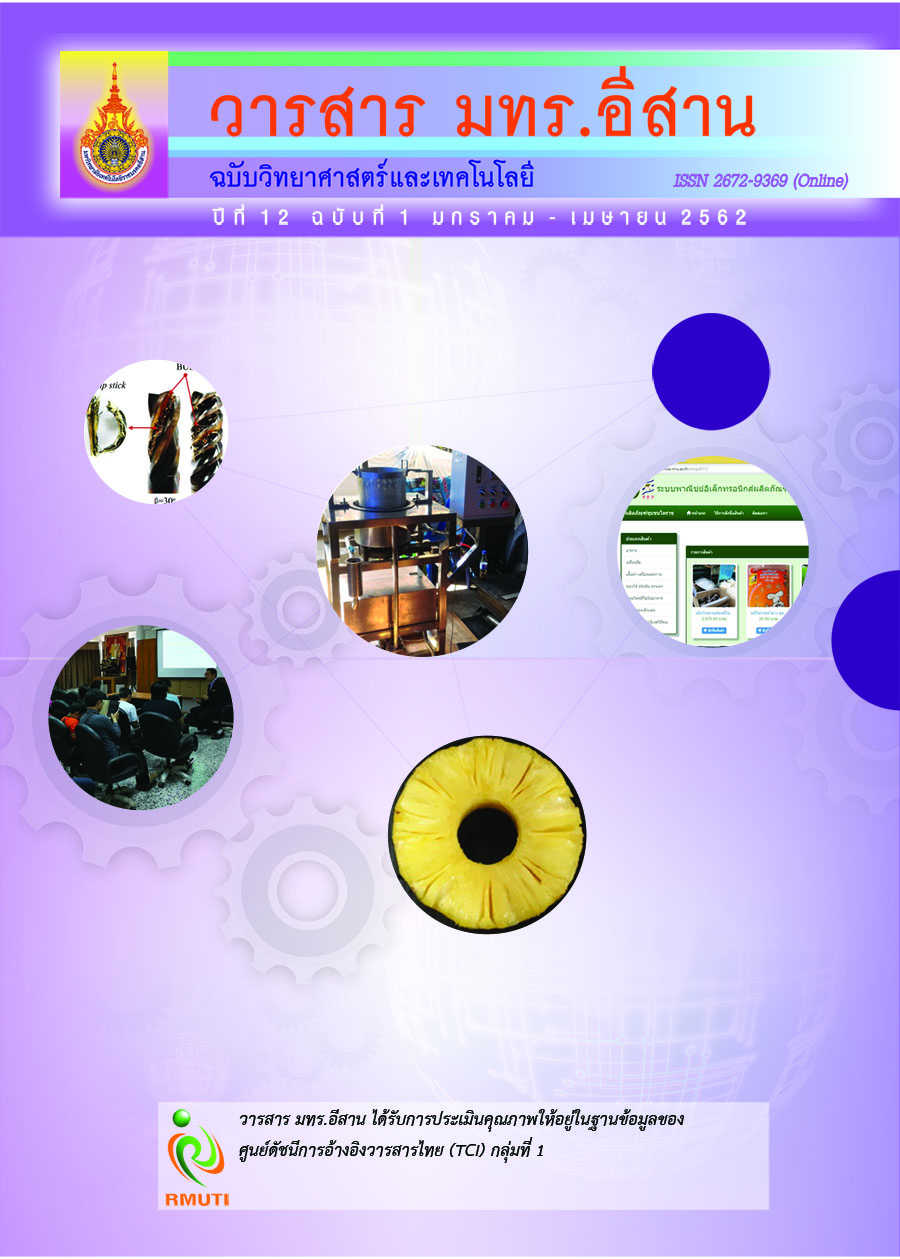Effects of Coconut Flower Sugar and Oligofructose Osmotic Process on Mass Exchange and Sensory of Pineapple Rings
Main Article Content
Abstract
Healthy sweeteners are beneficial for healthy food production. Coconut flower sugar is low in a glycemic index value. Oligofructose is prebiotic which lower in sweetness intensity than sucrose. This research aimed to study the effect of coconut flower sugar and oligofructose mixtures on mass exchange and sensory perception in osmosis process of pineapple rings. The ratio of coconut flower sugar to oligofructose was varied to 60:0, 45:15, 30:30, 15:45 and 0:60 (g/ 100 g), and compared with a sucrose solution. After osmosis of pineapple rings for 360 min., it was found that the sugar solutions showed different effects on mass exchange value, moisture content and sensory acceptance score (p < 0.05), but not on aw (p ≥ 0.05). The solution of 60 g/ 100 g coconut flower sugar resulted in the highest WL and WR, but the lowest overall sensory acceptance score (p < 0.05). The best condition was a ratio of coconut flower sugar to oligofructose as 15:45 g/100 g. After osmosis for 360 min., the WL, SG and
WR values were equal to 17.69, 6.82 and 10.70 %, respectively. The overall sensory acceptance score was 7.03. An application of osmotic solution in a mixed form is an
appropriate approach to osmotic dehydration of fruit.
Article Details
References
[2] Jacob, J. K. and Palliyath, G. (2012). Influsion of Fruits with Nutraceuticals and Health Regulatory Components for Enhanced Functionality. Food Research International. Vol. 45, Issue 1, pp. 93-102. DOI: 10.1016/j.foodres.2011.10.017
[3] Ahmed, I., Qazi, I. M., and Jamal, S. (2016). Developments in Osmotic Dehydration Technique for the Preservation of Fruits and Vegetables. Innovative Food Science and Emerging Technologies (INNOV FOOD SCI EMERG). Vol. 34, pp. 29-43. DOI: 10.1016/j.ifset.2016.01.003
[4] Secretaria, M. I. (2003). Comparison of The Elemental Content of 3 Sources of Edible Sugar-Analyzed. Access (29 December 2017). Available (https://realrawfood.com/coconutnectar-and-sugar)
[5] Silva, K. S., Fernandes, M. A., and Mauro, M. A. (2014). Effect of Calcium on the Osmotic Dehydration Kinetics and Quality of Pineapple. Journal of Food Engineering. Vol. 134, pp. 37-44. DOI: 10.1016/j.jfoodeng.2014.02.020
[6] Association of Official Analytical Chemist (AOAC). (1990). Official Method of Analysis. 15theds. Virginia: The Association of official Analysis Chemists. 972.20, Vol.2, Chapter 37, pp. 3-4
[7] Correa, J. L. G., Pereira, L. M., Vieira, G. V., and Hubinger, M. D. (2010). Mass Transfer Kinetics of Pulse Vacuum Osmotic Dehydration of Guavas. Journal of Food Engineering. Vol. 96, Issue 4, pp. 498-504. DOI: 10.1016/j.jfoodeng.2009.08.032
[8] Naknean, P. (2012). Factors Affecting Mass Transfer During Osmotic Dehydration of Fruits. International Food Research Journal. Vol. 19, pp. 7-18
[9] Alfaro, L., Siramard, S., Chouljenko, A., and Sathivel, S. (2018). Effect of Liquid Nitrogen Pretreatment on the Osmotic Dehydration and Quality of Cryogenically Frozen Blueberries (Vaccinium angustifolium Ait.). Food Bioscience. Vol. 22, pp. 165-169. DOI: 10.1016/j.fbio.2018.02.006
[10] Sinngam, A. (2012). Study on Prebiotic Properties of Fructo-oligosaccharide from Jerusalem Artichoke Extract. MSc. Biotechnology, Graduate School, Silpakorn University (in Thai)
[11] Nithiya, R. (2010). Food Chemistry. Bangkok: O-dean Store (in Thai)
[12] Matusek, A., Czukor, K., and Meresz, P. (2008). Comparison of Sucrose and Fructo-oligosaccharides as Osmotic Agent in Apple. Innovative Food Science and Emerging Technologies. Vol. 9, No. 3, pp. 365-373. DOI: 10.1016/j.ifset.2007.10.003
[13] Pattanapa, K., Therdthai, N., Chantrapornchai, W., and Zhou, W. (2010). Effect of Sucrose and Glycerol Mixtures in the Osmotic Solution on Characteristics of Osmotically Dehydrated Mandarin cv. (Sai-Namphaung). International Journal of Food Science and Technology. Vol. 45, No. 9, pp. 1918-1924. DOI: 10.1111/j.1365-2621.2010.02353.x
[14] Dermesolouoglou, E., Chalkia, A., and Taoukis, P. (2018). Application of Osmotic Dehydration to Improve the Quality of Dried Goji Berry. Journal of Food Engineering. Vol. 232, pp. 36-43. DOI: 10.1016/j.jfoodeng.2018.03.012
[15] Nutrients Review. (2016). Sweeteners. Access (6 April 2018). Available (https://www.nutrientsreview.com/articles/sweeteners.html)

